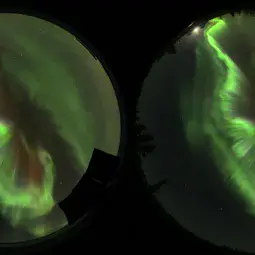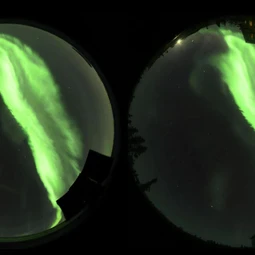Using digital SLRs to measure the height of Northern Lights
Scientific research doesn’t often start from outreach projects. Yet, Ryuho Kataoka from the National Institute of Polar Research in Tokyo, Japan, came up with an idea for a new method to measure the height of aurora borealis after working on a 3D movie for a planetarium. Kataoka and collaborators used two digital single-lens reflex (SLR) cameras set 8 km apart to capture 3D images of Northern Lights and determine the altitude where electrons in the atmosphere emit the light that produces aurora. The results are published today in Annales Geophysicae, a journal of the European Geosciences Union (EGU).
“We had initial success when we projected the digital SLR images at a planetarium and showed that the aurora could be seen in 3D. It was very beautiful, and I became confident that it should be possible to calculate the emission altitude using these images,” recalls Kataoka, who also works at the Graduate University for Advanced Studies (Sokendai) in Hayama, Japan. He teamed up with other Japanese researchers and an American scientist to do just that.
The separation distance between the human eyes is what allows us to see in 3D. When we look at an object, the images captured by the left and right eyes are slightly different from each other and when combined they give the brain the perception of depth. But because the distance between our eyes – about 5 cm – is small, this only works for objects that are not very far away.
Since aurora extend between about 90 and 400 km in altitude, a much larger separation distance is needed to see them in 3D. The researchers used two cameras, mimicking the left and right eyes, separated by 8 km across the Chatanika area in Alaska. Their two digital SLRs, equipped with fisheye lenses and GPS units, captured two simultaneous all-sky images that the researchers combined to create a 3D photograph of the aurora and measure the emission altitude.
“Using the parallax of the left-eye and the right-eye images, we can calculate the distance to the aurora using a [triangulation] method that is similar to the way the human brain comprehends the distance to an object,” explains Kataoka. Parallax is the difference in the apparent position of an object when observed at different angles.
Scientists have obtained altitude maps of aurora before. They are useful because they provide information about the energy of the electrons that produce the lights. But this is the first time the emission height of Northern Lights has been measured using images captured with digital SLR cameras. As the authors explain in the new Annales Geophysicae paper, the altitude maps obtained in this way are consistent with previous observations.
The technique is low cost and allows researchers to measure the altitude of small-scale features in the aurora. Further, it opens up the door for citizen scientists to get involved with auroral research.
“Commercially available GPS units for digital SLR cameras have become popular and relatively inexpensive, and it is easy and very useful for photographers to record the accurate time and position in photographic files. I am thinking of developing a website with a submission system to collect many interesting photographs from night-sky photographers over the world via the internet,” says Kataoka.
The researchers believe this may lead to new scientific findings, while working to engage the public in auroral research. After all, it was the beauty of 3D imaging of auroras that inspired Kataoka to develop a new tool for scientific research in the first place.
More information
This research is presented in the paper ‘Stereoscopic determination of all-sky altitude maps of aurora using two ground-based Nikon DSLR cameras’ to appear in the EGU open access journal Annales Geophysicae on 6 September 2013. Please mention the publication if reporting on this story and, if reporting online, include a link to the paper or to the journal website.
The scientific article is available online, free of charge, at http://www.ann-geophys.net/31/1543/2013/angeo-31-1543-2013.html.
The paper is authored by Ryuho Kataoka (National Institute of Polar Research, Tokyo, Japan and Graduate University for Advanced Studies [Sokendai], Hayama, Japan), Yoshizumi Miyoshi (Solar-Terrestrial Environment Laboratory, Nagoya University, Japan [STEL]), Kai Shigematsu (STEL), Donald Hampton (Geophysical Institute, University of Alaska, USA), Yoshiki Mori (Department of Mechanical Engineering, Shizuoka University, Japan), Takayuki Kubo (Department of Precision Engineering, The University of Tokyo, Japan [DPE]), Atsushi Yamashita (DPE), Masayuki Tanaka (Department of Mechanical and Control Engineering, Tokyo Institute of Technology, Japan), Toshiyuki Takahei (Orihalcon Technologies, Inc., Japan), Taro Nakai (Hydrospheric Atmospheric Research Center, Nagoya University, Japan), Hiroko Miyahara (Musashino Art University, Tokyo, Japan) and Kazuo Shiokawa (STEL).
The European Geosciences Union (EGU) is Europe’s premier geosciences union, dedicated to the pursuit of excellence in the Earth, planetary, and space sciences for the benefit of humanity, worldwide. It is a non-profit interdisciplinary learned association of scientists founded in 2002. The EGU has a current portfolio of 15 diverse scientific journals, which use an innovative open access format, and organises a number of topical meetings, and education and outreach activities. Its annual General Assembly is the largest and most prominent European geosciences event, attracting over 10,000 scientists from all over the world. The meeting’s sessions cover a wide range of topics, including volcanology, planetary exploration, the Earth’s internal structure and atmosphere, climate, energy, and resources. The 2014 EGU General Assembly is taking place is Vienna, Austria from 27 April to 2 May 2014. For information regarding the press centre at the meeting and media registration, please check http://media.egu.eu closer to the time of the conference.
If you wish to receive our press releases via email, please use the Press Release Subscription Form at http://www.egu.eu/news/subscribe/. Subscribed journalists and other members of the media receive EGU press releases under embargo (if applicable) 24 hours in advance of public dissemination.
Contact
Ryuho Kataoka
Associate Professor
National Institute of Polar Research
Tokyo, Japan
Phone +81-42-512-0929
Email kataoka.ryuho@nipr.ac.jp
Donald Hampton
Research Assistant Professor
Geophysical Institute, University of Alaska Fairbanks
Fairbanks, Alaska, USA
Phone +1-907-455-2256
Email dhampton@gi.alaska.edu
Bárbara Ferreira
EGU Media and Communications Manager
Munich, Germany
Phone +49-89-2180-6703
Email media@egu.eu
Links
- Read this press release in simplified language, aimed at 7–13 year olds, on our Planet Press site



